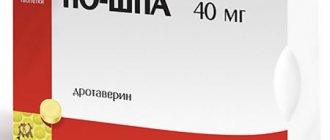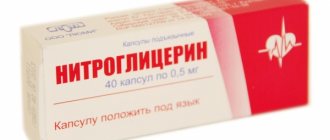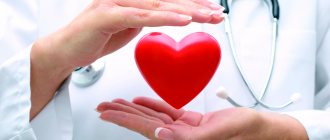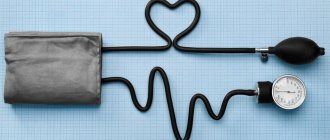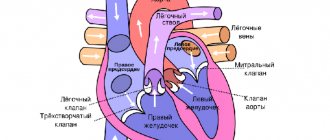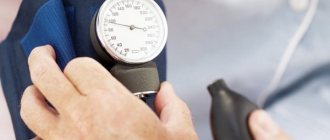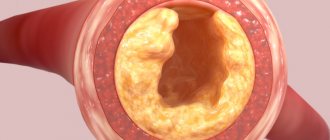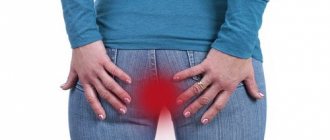In cardiology, there is a group of deviations that are named too generally to understand the essence of the phenomenon.
One of them is the so-called heart attack. This is a simple, common name for acute coronary insufficiency.
According to the clinical classification, the pathological process corresponds to a heart attack or unstable angina in the active phase (just at the moment of the attack).
The danger of the phenomenon is obvious. Regardless of the type, there is death or necrosis of cardiac tissue, myocardium, a decrease in the intensity of contractions, a drop in blood output and, as a result, ischemia, a weakening of general hemodynamics. The patient's death is possible.
Treatment is carried out strictly in a hospital. At the outpatient level, therapy continues and is adjusted; the condition is monitored by a cardiologist in the clinic.
Development mechanism
Regardless of the type of disease process, the essence is always approximately the same.
During the influence of one factor or another, there is a disruption of the normal blood supply to the myocardium through special arteries called coronary arteries.
The result is acute ischemia (oxygen starvation) of tissues. This phenomenon corresponds to an attack of angina pectoris, and if the degree of blood flow disturbance is great, to a heart attack.
During the episode, a slowdown or complete cessation of local hemodynamics and necrosis of cardiomyocytes (the actual units that make up the active muscular layer of the heart) are observed.
The process is accompanied by intense chest pain and other symptoms.
Without competent medical care, the contractility of the myocardium decreases, and blood output is insufficient.
The nutrition of the brain, organs and systems weakens. Hence additional manifestations, such as fainting and others.
The likelihood of death depends on the area of the lesion. The larger the lesion, the higher the risk of death.
A heart attack is an emergency condition accompanied by necrosis of cardiomyocytes and generalized symptoms and hemodynamic disturbances.
Recovery is carried out urgently, in a hospital or intensive care unit.
Common complications after a heart attack
This disorder is often accompanied by serious complications that can be life-threatening. These include:
- Arrhythmia is a heart rhythm disorder in which the heart begins to beat faster and faster and then stops (cardiac arrest);
- Cardiogenic shock is a condition in which the heart muscle is seriously damaged and ceases to supply sufficient blood to internal organs and tissues, which leads to disruption of many body functions;
- Heart rupture is the destruction of muscle tissue, walls or valves of the organ. Complications can occur soon after a heart attack and are one of the leading causes of death.
Many men can die suddenly from complications before they even get to the hospital, or within a month after a heart attack.
The prognosis often depends on the following factors:
- Age – the likelihood of severe complications increases with age;
- The severity of the disorder - how badly the heart muscle was damaged during the attack;
- How much time passed before medical assistance was received - treatment should be started as early as possible.
Classification
The main criterion is the nature of the pathological process. It has already been mentioned in passing that a heart attack is a simplified name for two phenomena.
Which ones:
Angina pectoris
Usually unstable form. Its essence lies in disruption of the normal nutrition of the heart muscle. But the volume of the lesion is not yet enough to cause extensive destruction of cardiac structures.
This form is characterized by constant, smooth or spasmodic progression without signs of improvement even with full therapy.
Recovery requires lifelong medication without any guarantees. Effective treatment is possible only at stages 1-2.
Heart attack
The second option is coronary insufficiency. Develops in response to critical narrowing or blockage of the arteries supplying the heart.
The essence is approximately the same - the death of muscle structures, only the volume of destroyed cells is greater. A heart attack occurs immediately, like an avalanche, in contrast to angina, when the development of the same condition may take more than one year, this is the main difference.
Treatment in intensive care, and then in the cardiology department. The prospects are vague. The prognosis depends on the quality of first aid and the area of involvement in the destructive process.
Providing first aid until the doctor arrives.
- If acute pain occurs, which by all indications can be mistaken for a heart attack, and does not disappear after taking the available nitrates, you should, without wasting time, call the ambulance service.
- A patient with these pain symptoms should be tried to be calmed down and put to bed, asked not to engage in physical activity.
- If signs of lack of air appear, the patient must be given a sitting position in bed, placing pillows or other objects under his back. Clothing that restricts breathing is unbuttoned. Windows are opened in the room to allow fresh air to enter.
- You can offer half a tablet of acetylsalicylic acid from your home medicine cabinet. It is important to chew the tablet so that acetylsalicylic acid acts faster.
- It is not advisable to use other medications before doctors arrive, as there is a risk of worsening the course of a heart attack and their use is only possible under medical supervision.
A patient with such symptoms needs constant qualified supervision. The necessary help, in such cases, can only be obtained in a specialized hospital, therefore, if signs of a developing myocardial infarction appear, hospitalization should not be abandoned.
Causes
Factors in the development of an attack are divided into three groups.
- The first directly create the ground for the beginning of the state, being a kind of foundation.
- The latter increase the risk of developing a deviation.
- Still others act as triggers, trigger mechanisms for the onset of the phenomenon.
Etiological points
- Atherosclerosis. Almost the main process (up to 93% of cases) that causes the development of a heart attack (more precisely, coronary insufficiency in general).
Depending on the nature of the defect, two forms are distinguished.
Occlusion or blockage is considered a classic clinical case. The phenomenon consists of closing the lumen of the artery with a cholesterol plaque, or less often with a blood clot. May be partial or complete.
In the second case, vessel obstruction occurs, treatment is extremely difficult. The probability of death is almost 100%.
Another clinical option is stenosis or narrowing of the lumen of the coronary artery. The essence is the disruption of blood flow due to the difficult passage of liquid connective tissue through the vessels.
The result is ischemia (oxygen starvation) of tissues, and with stenosis of more than 70% of the lumen, the first symptoms of an attack occur.
Correction is carried out using surgical methods. Most often, there is a congenital or acquired anomaly of the great arteries.
- Vasculitis. Or an inflammatory disease of the walls of blood vessels (endothelium).
More often it is of an autoimmune nature, running parallel to other pathological processes (systemic lupus erythematosus or rheumatism).
Viral origin is also possible, but is much less common. The disease is always secondary and does not develop in isolation from other pathological processes.
Requires complex therapy. Without help, scarring of the artery occurs with a proportional narrowing of the lumen of the blood vessel. This is a difficult condition to treat. Prosthetic replacement of the affected area is required.
- Hypertonic disease.
Its essence is a stable increase in blood pressure. The danger comes from the second degree and beyond.
The first one proceeds relatively sluggishly, in addition, the tonometer readings are inconsistent, and there is no significant increase in the numbers. But this is the first alarm bell; it indicates the need for treatment.
Transformation and progression occur in a short period of time, sometimes a few months are enough. Recovery under the supervision of a cardiologist.
Excessive stress on the heart leads to chronic malnutrition. Sooner or later a heart attack will occur. Angina pectoris is possible, but not required.
- Diabetes. A systemic endocrine disease associated with insufficient insulin production or decreased tissue sensitivity to it.
Both options have a poor prognosis without treatment. And therapy does not provide a 100% guarantee of complete recovery.
The hallmark of the pathological process is generalized vascular damage, which is determined by stenosis, that is, narrowing.
Hence secondary atherosclerosis, including structures of the lower extremities, brain, coronary arteries.
- Other hormonal diseases. Hypercotricism occurs, that is, excessive synthesis of thyroid substances, excessive production of cortisol by the adrenal glands and other phenomena.
All of them turn out to be the culprits of vasoconstriction. Treatment is planned. Advanced forms are treated in a hospital under the supervision of a group of specialists, in order to avoid fatal consequences.
Risk factors
The second category of reasons or high-risk moments:
- Smoking. Patients who use tobacco have a 70% greater risk of heart attack than those who lead a healthy lifestyle. Research shows that not only experience plays a role, but also individual resistance to toxic agents, which is genetically determined. Therefore, the same time of tobacco consumption will cause different consequences in two different individuals. A drop of nicotine does not always kill, but the results are inevitable. No one will say when they will arise in a month, a year or more. You need to monitor the patient's condition.
- Alcohol consumption. Ethyl alcohol leads to general disturbances in blood vessels and blood pressure quite quickly. But again, individual resistance to ethanol plays a role, which is different for everyone.
- Obesity. It is not the increased weight itself that matters, but what lies behind it. In this case we are talking about a violation of lipid metabolism. Fats are distributed unevenly, and their normal deposition is deviated. The process is corrected with great difficulty; the main way to avoid adverse consequences is to change the very principle of nutrition (in other words, diet).
- Insufficient or excessive physical activity. In the first case, stagnant processes begin, myocardial contractility and vascular stenosis decrease. In another, there is a proliferation of cardiac tissues and compression of the coronary arteries. Both options are unfavorable. While the first is potentially curable, the second has negative prospects.
- Age 45+, male.
Trigger factors
- Stressful situation. Associated with the release of large amounts of cortisol and adrenaline, which provoke coronary artery stenosis. Depending on the extent of the narrowing, one of two types of heart attack is observed.
- Excessive physical activity. The required level of activity depends on the individual characteristics of the patient’s body and his fitness level. For some, it is enough to climb the stairs to the third floor to provoke an attack; for others, even a kilometer of jogging is not enough.
- Hypothermia. An exception.
The causes of a heart attack are both cardiac and non-cardiac. A group of factors plays a role; together they give rise to the pathological process. Eliminating the trigger or moment of risk is not enough. We need to fight all three categories.
Risk factors for heart attack in men
Even young guys can fall into the risk zone, so you should approach this point with special attention.
- Age . The older the man, the higher the risk.
- Heredity . If one of the parents suffered from heart problems.
- Bad habits . Alcoholic drinks, alcohol, smoking - they are not even discussed, everything is obvious.
- High blood cholesterol levels . In combination with bad habits and stress, cholesterol leads to disruption of the heart.
- Diabetes . Diabetics often suffer from heart disease.
- Obesity and inactivity . The heart becomes overgrown with fat and it is more difficult for it to pump blood, the vessels lose their elasticity.
- Constant stress . Avoid situations and thoughts that make you nervous and constantly worry.
Symptoms and first signs of a heart attack
The manifestations are specific, but there are no differences in symptoms between women and men. If you look closely, this gives reason to suspect an attack right away.
Approximate clinical picture:
- Chest pain of varying degrees of intensity is a typical symptom of a heart attack. Against the background of angina pectoris, it is of average strength, it burns and presses. It radiates to the left arm and shoulder blade. Lasts no more than 30 minutes. With a heart attack, the manifestation is much more active, occurs suddenly, and lasts for over half an hour. Attempts to independently distinguish between the two states are futile. Instead of dubious exercises, it is better to call an ambulance.
- Dyspnea. In complete peace. The patient is unable to draw in air to meet the need. Such symptoms are determined by impaired gas exchange.
- Feelings of anxiety, panic, fear. Corresponds to a neurotic state.
- Loss of consciousness. Up to several times in a row. An alarming sign indicating a weakening of brain nutrition.
- Cyanosis of the nasolabial triangle. Blue discoloration of the area around the mouth.
- Paleness of the skin.
- Arrhythmia type bradycardia (weakening of contraction frequency).
Signs of a heart attack develop almost instantly, and the duration of the episode is from 10 minutes to 30 with angina pectoris, and more against the background of an ongoing heart attack.
How to recognize an emergency?
It’s not easy to do this without qualifications. A distinction is made between the main types of coronary insufficiency; it is also necessary to distinguish the described disease from intercostal neuralgia, perforated gastric ulcer, pneumonia and other phenomena.
What characterizes heart pain:
- Lack of response to breathing. Inhalation and exhalation do not affect the intensity of the syndrome. The same cannot be said about signs of non-cardiac discomfort.
- No changes when moving. If you stand up, sit down, lie down, the power of manifestation will be the same. This is the trait of heartache.
With intercostal neuralgia, the pain intensifies with inhalation and movement.
A perforated ulcer is defined by a sharp, cutting sensation in the abdomen and epigastric region. It is this nature of pain that makes it possible to distinguish the condition from others.
Pneumonia causes predominantly respiratory symptoms.
Diagnosis falls on the shoulders of doctors. There is no point in guessing on the coffee grounds. The brigade should be called. An attack can be recognized by the nature of the pain, its duration, and additional manifestations.
First aid
Before the doctors arrive, you only need to stabilize the patient’s condition at home. Not to cure it, but just to normalize the situation.
Approximate algorithm:
- Make the patient sit down and place a cushion of clothing or linen under his back. You cannot lie down, because normal gas exchange will be disrupted, pulmonary edema or other additional complications will occur.
- Open the window to ensure a flow of fresh air into the room.
- Give the patient a Nitroglycerin tablet to relieve pain. In case of a heart attack, the measure may be ineffective, but other drugs cannot be taken. The condition is unstable; any outside influence leads to a worsening of the situation.
- Loosen the collar, remove tight body jewelry.
If you lose consciousness, it is recommended to turn your head to the side so that the person does not choke on vomit during the reflexive release of the digestive tract.
Upon arrival, doctors should briefly describe the condition. Transportation to a cardiology hospital is indicated.
Effective measures can only be taken in a hospital. First aid for a heart attack consists of two things: calling an ambulance, stabilizing the condition of the injured person.
What should you do during a heart attack?
Step-by-step recommendations for a sudden attack:
- Give the patient a special position: lay him down so that the upper part of the body is higher than the lower part, the legs are raised and bent at the knees, you can leave him in a semi-sitting but comfortable position.
- The surface on which a person is placed with an attack should be hard, this will reduce the load on the heart muscle.
- You should calm the person down or give sedatives, Valocardine, valerian.
- To allow oxygen to reach the lungs, open a window or turn on the air conditioner, and unfasten tight clothing, especially around the neck.
- Place a nitroglycerin tablet under the tongue, supporting the patient's lower jaw.
- After 15 minutes, add another tablet.
- To relieve pain, 1 tablet of Aspirin is given; it thins the blood and prevents thrombosis.
- Before the medical team arrives, you should monitor your pulse, breathing, and check your blood pressure.
- If you lose consciousness, you should make a sharp and strong blow to the sternum, in the area of the heart.
- If the previous procedure did not give positive success, then at the next stage an indirect cardiac massage is performed, alternating it with artificial respiration.
- The massage is performed with two clasped hands. Hands must be pressed quickly, in a rapid rhythm, approximately 2 times per second, into the area between the sternum and mammary glands.
- The massage alternates with artificial respiration using the “mouth to mouth” principle.
- After 30-35 chest compressions, 2-3 inhalations and exhalations are made.
- If the pulse continues to be absent, then the procedures are carried out before the doctors arrive.
- The first positive signs: the appearance of a pulse, a pink complexion, the reaction of the pupils to light.
Necessary examinations
Upon admission to the department, diagnostics are carried out urgently. Usually, results are not expected; urgent measures are indicated to bring basic vital signs back to normal. Then more careful work is needed.
Approximate list of events:
- Oral interview with the patient and collection of anamnesis. What matters is the number of attacks and how often they occur (if they have happened before).
- Measurement of blood pressure and heart rate.
- Daily monitoring. Registration of the same indicators within 24 hours using a Holter monitor. Can be carried out repeatedly to clarify conditions. The study answers the question about the dynamics of blood pressure and heart rate throughout the day, depending on circadian phenomena.
- Electrocardiography. Shows even slight arrhythmia. All functional deviations are clearly visible.
- Echocardiography. Demonstrates defects and the degree of destruction of cardiac tissues. This visual technique is essentially a version of ultrasound.
- General blood test, biochemical and hormone tests.
Treatment
An approximate regimen of drug correction involves a long course of taking the following drugs:
- Angiagrangants. To thin the blood. Aspirin Cardio will do. This is a must-have pharmaceutical.
- Statins. In order to eliminate cholesterol plaques in the coronary arteries and more. Atoris as the main one. It is possible to use analogues at the discretion of the specialist.
- Beta blockers. Metoprolol, Anaprilin.
- Antihypertensives as needed. Reduce blood pressure.
- Nitroglycerin for pain relief. They are not taken constantly, but as part of relieving the discomfort.
- Diuretics. Regularly (several times a week) to remove excess fluid from the body.
- Cardioprotectors. Mildronate and the like.
- Potassium and magnesium preparations. In order to restore local metabolism.
Surgical treatment is indicated for vascular abnormalities, significant stenosis or advanced atherosclerosis.
The nature of the intervention is determined by a specialist. Most often, stenting or bypass surgery is performed.
The attack that has occurred imposes some restrictions on the patient’s life:
- You need to completely give up smoking and alcohol.
- You can't physically overload. Only walking and light exercise prescribed by a doctor.
- You should also adjust your diet. Fatty and fried foods are excluded; fortification of the menu is indicated. Salt no more than 7 grams per day.
An approximate list of products is indicated in treatment table No. 10. Based on the presented list, conclusions can be drawn. It is recommended to discuss any controversial issues with a nutritionist.
